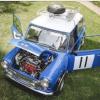With higher compression and longer duration cams, accurate cam timing becomes more important. Even from the seat of my pants, I can notice a 2 degree difference.
First you want to find TDC. With the head on, this is not the most accurate as it also measures piston rock, which it totally normal to have, but you need to make a Piston Stop.
Take an old spark plug, carefully break all the porcelain from it (I'd recommend wearing googles when doing this and be aware the edges of the material can be razor sharp), break the earth electrode from the metal body, then tap a suitable thread (I find an M10 works OK) through what's left of the body. Find a long set screw (this is a bolt that has the thread going all the way to the bolt head) that fits the thread you've just tapped, it will need to be around 60 mm long and you may want a lock nut on it.
Fit your Protractor to your Harmonic Damper and then a wire pointer to be able to read off the crank angle, you want this a little long so you can later bend it to calibrate the Protractor to the Crank Angle, so line it all up at your best judgement around zero at TDC, though don't worry too much about how far off it is, within 10 or even 20 degrees at this point is good enough.
You might be temped to just use the Timing Marker on the Damper and Timing Chain cover, but the Marker on the Damper could be off for a few reasons. You can later check this.
Remove your Spark Plugs, bring the engine up near TDC but not quite at TDC. Screw in the Threaded Spark Plug Body in to No. 1 Cylinder, then screw in your Set Screw until it touches the Piston. Lock it off with the Locknut. This is your Piston Stop. Back the Crank / Piston off by turning the Crank by hand, then bring it up to the Piston Stop. You want it firm against it but not hard in to it, be mindful here too that going hard could bend the Set Screw in the Piston Stop.
Note down the angle on your Protractor here. Then wind the crank back the other way to the Piston Stop with the same pressure on it as previously used. Note down the Crank Angle indicated here, then average the first and second numbers measured. Remove the Piston Stop, turn the Crank over to that calculated Angle, then move the Pointer to Zero. You now have the Protractor calibrated to the Crank.
From here you can use your Dial Gauge to either measure off a Push rod, the Rockers (not so good) or a Valve Cap to measure your Cam Angles. To check for Peak Lift, if the Cam is a Symmetrical Grind, I'd suggest measuring the angles at so 5 thou before and after peak lift, then averaging them to obtain the peak lift angle. Trying to measure peak lift directly is fraught with inaccuracy as there's some dwell at peak lift.
In regards to allowing for 'fudge factors' I usually allow an advance of 2 degrees when running a chain to allow for settling of the chain in the sprocket teeth. If running a belt, I set them spot on.
If you make your Cam Angle Measurements directly off the Valve Cap you need not make any allowances for any changes in the valve train and if one was to make allowances here, there's many variables to consider - valve spring pressures and this varies depending on the Cam Lift and Springs used, Cam Profile and Lift, Push Rods used, Rocker Shaft used and on it goes - however none of these will change the angle at which the Valve opens and closes at, only the total lift. I wouldn't be making any compensations here.
 Steuerzeiten_KetteNeu_LR.jpg 48.68K
3 downloads
Steuerzeiten_KetteNeu_LR.jpg 48.68K
3 downloads



















